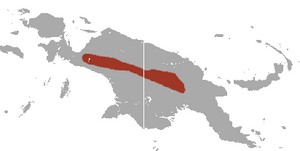Pygmy ringtail possum facts for kids
Quick facts for kids Pygmy ringtail possum |
|
|---|---|
| Conservation status | |
| Scientific classification | |
| Genus: |
Pseudochirulus
|
| Species: |
mayeri
|
 |
|
| Pygmy ringtail possum range | |
| Synonyms | |
|
Pseudocheirus mayeri (Rothschild & Dollman, 1932) |
|
The pygmy ringtail possum (Pseudochirulus mayeri) is a small marsupial. It belongs to the family Pseudocheiridae. You can find this animal in West Papua, Indonesia, and Papua New Guinea. They live in mountain forests. These possums are common along the Central Cordillera. They live high up, between 1,500 and 3,600 meters (about 4,900 to 11,800 feet) above sea level.
Pygmy ringtails are herbivores. This means they eat plants. They mostly eat leaves, but also enjoy pollen, lichen, and fungus. They also munch on "epiphytic moss," which grows on trees. Sometimes, they even eat tree bark. This bark gives them important nutrients like calcium and potassium.
Contents
What do Pygmy Ringtail Possums Eat?
Pygmy ringtails have special teeth. Their large front teeth help them snip off pieces of plants. Their back teeth are good for shredding the leaves they eat. They also have a special part in their gut called a cecum. This acts like a fermentation chamber. It helps tiny bacteria break down tough plant material. This way, the possum gets all the nutrients from its food.
How Big Are Pygmy Ringtail Possums?
The pygmy ringtail possum is a very tiny animal. Males are usually a bit smaller than females.
- Female possums weigh about 154.5 grams (around 5.4 ounces). They can be from 105 to 206 grams.
- Their length is about 372 millimeters (around 14.6 inches). They can range from 330 to 400 millimeters long.
- Male possums weigh about 149 grams (around 5.2 ounces). They can be from 115 to 178 grams.
- Their length is about 344 millimeters (around 13.5 inches). They can range from 318 to 369 millimeters long.
In the wild, these possums usually live for about 4 or 5 years.
What do Pygmy Ringtail Possums Look Like?
These pygmy ringtails have fur that can be cinnamon brown to dark brown. When they move, you might see a bluish-gray color underneath their fur. Their tail has thick brown hair on top. But underneath, it's hairless and tough, like a callus. This helps them grip branches. They also have a special first toe on their back feet that can grab things. Their second and third toes are joined together, which is called syndactyly.
How do Pygmy Ringtail Possums Live?
These possums build nests called dreys. They make these nests in the forks of trees. Their dreys are usually less than four meters (about 13 feet) off the ground. They use things like moss and lichen to build their nests. During the day, they often go into a state of partial torpor. This means they slow down their body functions to save energy.
Pygmy ringtail possums are nocturnal. This means they are active at night. They are also solitary, meaning they live alone. Since they are small and move slowly, they don't travel far from their drey at night.
How do Pygmy Ringtail Possums Communicate?
Pygmy ringtails can use sounds to talk to each other. For example, young possums make a twittering sound when they are looking for their mother. They also make a screeching noise if they sense danger. However, they mostly communicate using their sense of smell, which is called olfaction.
Males produce a special scent from a gland on their chest. This scent helps keep other males away. Both male and female possums use their droppings and other scents to mark their territory. This also helps them show if they are ready to mate.
Who Hunts Pygmy Ringtail Possums?
The main animals that hunt pygmy ringtail possums are owls. Specific types of owls include the greater sooty owl, Papuan hawk-owl, eastern grass-owl, and rufous owl. People who live near their habitat also hunt them. However, they are not hunted so much that their numbers are in danger.


